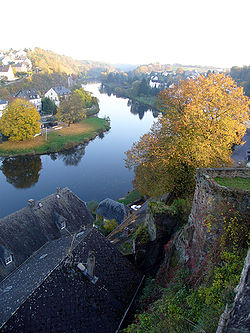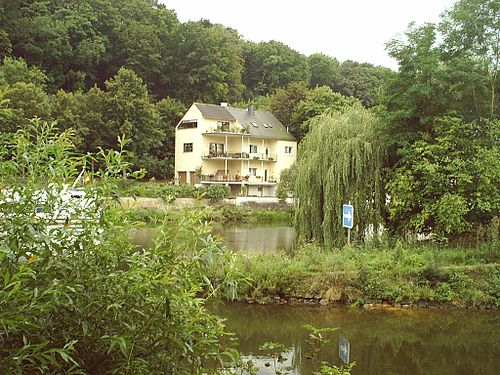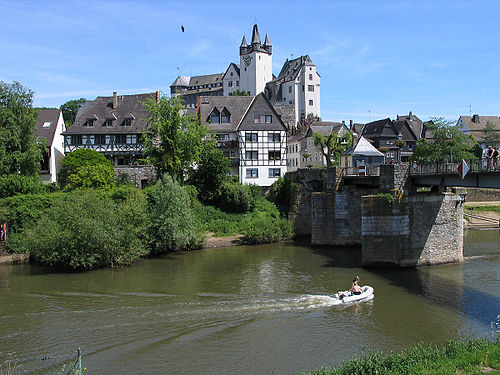Lahn
| Lahn | |
|---|---|
 Map of the Lahn from its source in the Rothaargebirge to its mouth near Koblenz | |
 | |
| Location | |
| Country | Germany |
| Physical characteristics | |
| Source | |
| • location | Near the Lahnhof in the municipality of Netphen, North Rhine-Westphalia |
| • coordinates | 50°53′32″N 8°14′30″E / 50.89222°N 8.24167°E |
| • elevation | 602 m (1,975 ft) |
| Mouth | |
• location | Rhine at Lahnstein, Rhineland-Palatinate |
• coordinates | 50°18′32″N 7°35′42″E / 50.30889°N 7.59500°E |
• elevation | 61 m (200 ft) |
| Length | 245.6 km (152.6 mi) |
| Basin size | 5,925.6 km2 (2,287.9 sq mi)[1] |
| Discharge | |
| • average | 54 m3/s (1,900 cu ft/s) |
| Basin features | |
| Progression | Rhine→ North Sea |
Lahn | ||||||||||||||||||||||||||||||||||||||||||||||||||||||||||||||||||||||||||||||||||||||||||||||||||||||||||||||||||||||||||||||||||||||||||||||||||||||||||||||||||||||||||||||||||||||||||||||||||||||||||||||||||||||||||||||||||||||||||||||||||||||||||||||||||||||||||||||||||||||||||||||||||||||||||||||||||||||||||||||||||||||||||||||||||||||||||||||||||||||||||
|---|---|---|---|---|---|---|---|---|---|---|---|---|---|---|---|---|---|---|---|---|---|---|---|---|---|---|---|---|---|---|---|---|---|---|---|---|---|---|---|---|---|---|---|---|---|---|---|---|---|---|---|---|---|---|---|---|---|---|---|---|---|---|---|---|---|---|---|---|---|---|---|---|---|---|---|---|---|---|---|---|---|---|---|---|---|---|---|---|---|---|---|---|---|---|---|---|---|---|---|---|---|---|---|---|---|---|---|---|---|---|---|---|---|---|---|---|---|---|---|---|---|---|---|---|---|---|---|---|---|---|---|---|---|---|---|---|---|---|---|---|---|---|---|---|---|---|---|---|---|---|---|---|---|---|---|---|---|---|---|---|---|---|---|---|---|---|---|---|---|---|---|---|---|---|---|---|---|---|---|---|---|---|---|---|---|---|---|---|---|---|---|---|---|---|---|---|---|---|---|---|---|---|---|---|---|---|---|---|---|---|---|---|---|---|---|---|---|---|---|---|---|---|---|---|---|---|---|---|---|---|---|---|---|---|---|---|---|---|---|---|---|---|---|---|---|---|---|---|---|---|---|---|---|---|---|---|---|---|---|---|---|---|---|---|---|---|---|---|---|---|---|---|---|---|---|---|---|---|---|---|---|---|---|---|---|---|---|---|---|---|---|---|---|---|---|---|---|---|---|---|---|---|---|---|---|---|---|---|---|---|---|---|---|---|---|---|---|---|---|---|---|---|---|---|---|---|---|---|---|---|---|---|---|---|---|---|---|---|---|---|---|---|---|---|---|---|---|---|---|---|---|---|---|---|---|---|---|---|---|---|---|---|
| ||||||||||||||||||||||||||||||||||||||||||||||||||||||||||||||||||||||||||||||||||||||||||||||||||||||||||||||||||||||||||||||||||||||||||||||||||||||||||||||||||||||||||||||||||||||||||||||||||||||||||||||||||||||||||||||||||||||||||||||||||||||||||||||||||||||||||||||||||||||||||||||||||||||||||||||||||||||||||||||||||||||||||||||||||||||||||||||||||||||||||
The Lahn (German pronunciation: [laːn] ⓘ) is a 245.6-kilometre-long (152.6 mi), right (or eastern) tributary of the Rhine in Germany. Its course passes through the federal states of North Rhine-Westphalia (23.0 km), Hesse (165.6 km), and Rhineland-Palatinate (57.0 km).
It has its source in the
.Tributaries to the Lahn include the
Source area

The Lahn is a 245.6-kilometer (152.6 mi)-long, right (or eastern) tributary of the Rhine in Germany. Its course passes through the federal states of North Rhine-Westphalia (23.0 km), Hesse (165.6 km), and Rhineland-Palatinate (57.0 km).
The Lahn originates at the Lahnhof, a locality of Nenkersdorf, which is a constituent community of Netphen in southeastern North Rhine-Westphalia, near the border with Hesse. The source area is situated along the Eisenstraße scenic highway and the Rothaarsteig hiking trail.
The river arises in the southeastern Rothaargebirge in the Ederkopf-Lahnkopf-Rücken ridge-line natural area. This ridge is the drainage divide between the Rhine and Weser, and, within the Rhine system, the watershed between the rivers Lahn and Sieg.
The source is at an elevation of 600 meters (2,000 ft) and is located southwest of the 624 m (2,047 ft) high Lahnkopf. In the vicinity are also the origins of the Eder (5.5 km northwest of the Lahnhof) and the Sieg (another 3 km north). Whereas the Sieg takes the shortest route to the Rhine (to the west), the Lahn first runs in the opposite direction, paralleling the Eder for many kilometers.
Course
The Lahn first flows in a northeasterly direction through the southeastern Rothaargebirge and its foothills. From about the Bad Laasphe community of Feudingen, it turns primarily to the east.
Upper Lahntal and Wetschaft Depression


The section of the Lahn below the town of Bad Laasphe is geographically known as the Upper Lahn Valley (German: Ober Lahntal). Above Bad Laasphe, where the river flows between the Rothaargebirge on the left (i.e. to the north) and the Gladenbach Uplands on the right, the Lahn Valley is simply considered part of these mountains.
Between Niederlaasphe (of Bad Laasphe) and Wallau (of
Shortly after the village of Caldern (of Lahn Valley), the ridgeline of the Rothaargebirge on the north ends with the Wollenberg and that of the Gladenbach Bergland with the Hungert. The Lahn leaves the
Marburg-Gießen Lahntal
The now southward-flowing Lahn then enters the Marburg-Gießen Lahntal. Shortly before Cölbe, the Ohm enters from the left at the Lahn-Knie named area. Flowing from the Vogelsberg through the Ohmtal, the Ohm is the Lahn's longest tributary, with a length of 59.7 kilometres (37.1 mi).
The river then breaks through a
The Gießen Basin is surrounded by the mountain peaks of the Gleiberg, the Vetzberg, the Dünsberg, and the Schiffenberg. At Wetzlar, the Lahn is joined by its second longest tributary, the Dill, which has a length of 55.0 kilometres (34.2 mi). At this location, the valleys of the Lahn and Dill separate three parts of the Rhenish Slate Mountains from each other: the Gladenbach Bergland, the Westerwald to the northwest, and the Taunus to the south.
Weilburg Lahntal

After Wetzlar, the valley of the Lahn gradually narrows and at Leun enters the Weilburger Lahntal. The Weilburger Lahntal belongs to the larger Gießen-Koblenzer Lahntal physiographic province, considered part of the Rhenish Slate Mountains.
In the upper area of the Weilburg Lahntal (the Löhnberg Basin) are
. In the lower area, where the river turns again to the south, the Lahn is entrenched canyon-like below the level of the surrounding geographic trough.The city of Weilburg is wrapped by a marked loop of the river. The neck of this noose is traversed by a boat tunnel, unique in Germany. A little below Weilburg, the Weil, originating in the High Taunus, enters the Lahn.
Limburger Basin
At Aumenau in the municipality of
Lower Lahntal
Below

History
Early history

The Lahn area was settled as early as in the
In the
During the
The origin and meaning of the name Lahn are uncertain; it is possible that it is a pre-Germanic word. The form of the name changed over time; before 600, variations like Laugona, Logana, Logene or Loyn are typical. The oldest known use of the current spelling of the name dates to 1365.
The oldest mention of the
In the 17th and early 18th centuries, there were several initiatives of adjacent princes to further expand the Lahn as a waterway, but they all failed due to lack of coordination. In 1740, the
By the end of the 19th century, over 300 castles, fortresses, fortified churches, and similar buildings were built along the river.
Shipping during the Industrial Revolution
During the French occupation, inspections of the river began in 1796, which were to be followed by a comprehensive expansion. Due to political developments, however, this expansion did not take place. The newly created Duchy of Nassau eventually began work from 1808 under the Chief Construction Inspector of Kirn to make the Lahn fully navigable. In the first winter, the section of the riverside from the mouth to Limburg was stabilized, particularly so that the course could be narrowed in shallow places. It was planned in the long run to make the Lahn navigable as far as Marburg and from there to construct a canal to Fulda to connect it with the Weser. This would create a waterway from France to North Sea via the states of the Confederation of the Rhine. Upstream of Limburg, however, the work was slow, partly because the population pressed into emergency service only reluctantly cooperated. Large parts of the shore were only secured with fascines, which rotted shortly thereafter.
In 1816 the Duchy of Nassau and the Kingdom of Prussia agreed to expand the Lahn as far as Giessen, where it joined the Grand Duchy of Hesse. Little is known about the work that followed, but in the 1825 boatmen on the Lahn who shipped mineral water from springs in Selters and Fachingen addressed a letter of appreciation to the Nassau government in Wiesbaden for the rehabilitation of river systems. Overall, however, there seems to have been only repairs and temporary works accomplished through the 1830s.
The earliest attempts to count ship traffic on the Lahn dated from 1827. At the
Given the increasing ore mining in the Lahn Valley, officials from Nassau and Prussia in 1841 made an inspection trip along the river from Marburg to the Rhine. The Prussians were the driving force behind river expansion projects, seeking to establish a connection between Wetzlar and their Rhine Province and to secure the iron ore supply for the growing industry in the Ruhr Valley. Until 1844, Hesse-Darmstadt also joined expansion efforts, while Hesse-Kassel declined participation. The participating governments agreed to make the Lahn passable as far as Gießen for boats that were significantly larger than the existing vehicles on the river. In Prussian territory, the work was largely completed by 1847, including construction of locks in Dorlar, Wetzlar, Wetzlar-Blechwalze, Oberbiel and Niederbiel. In Nassau's territory, locks were built at Löhnberg, Villmar, and Balduinstein, as well as the greatest technical achievement: the Weilburg ship tunnel. The river bank reinforcement and channel deepening along Nassau's section of the Lahn, however, was slow. Moreover, when the lock at Limburg fell short of the width contractually agreed upon, Nassau refused an extension. This led to several clashes between Nassau and Prussia in the following years until Nassau had finally fulfilled its obligations in 1855.
Despite the expansion, boats on the Lahn could travel fully loaded only from Gießen to Löhnberg. There, they had to lighten their load in order to reduce their draft and continue the journey. Also, this was only during two to three months. In a further four to five months per year, the load had to be reduced even earlier due to the low water level. The rest of the year the Lahn was not passable. From Wetzlar to Lahnstein, where the freight was unloaded onto the large barges of the Rhine, the boats took three to four days. A trip from Wetzlar to the mouth and then towed back with horses lasted for about 14 days in good conditions. At that time, there were mainly two types of transport boats in use: those with a capacity of 350 hundredweights and a larger variant with a capacity of 1300 hundredweights.
In 1857 to 1863, the Lahntal railway (Lahntalbahn) was built, with nine major bridges and 18 tunnels along the river. Afterward, Prussia and Nassau tried to keep shipping along the Lahn alive through the lowering of tariffs. Ultimately, however, rail gained acceptance as a means of transport and cargo shipping on the Lahn gradually declined. Several projects begun in 1854 to operate steamboats on the Lahn died in their infancy. In 1875, 1885 and 1897 the Prussian government discussed plans for the transformation of the Lahn into a canal, which would allow the passage for larger vessels, but these plans were never implemented. Only in places was the riverbed dredged, such as around 1880 near Runkel, from 1905 to 1907 from the mouth to Bad Ems, and from 1925 to 1928 from the mouth to Steeden.
In 1964, an expansion of the Lahn for 300-ton vessels was completed. In 1981, freight shipping on the Lahn came to an end. Today, the Lahn is used exclusively for recreational boats.
Recent history
In 1960, gravel mining began in the broad plains of the Lahn Valley in Marburg and Giessen. This ended in 1996 and large sections of Lahn Valley in Hesse were set aside as a nature reserve
On 7 February 1984, the Lahn experienced a 100-year flood, which caused millions of German Marks in damage. This has since led to a central flood warning system and coordination of flood control efforts through the regional council of Giessen.
Boating
The Lahn, from a point between Lahnau and Dutenhofen (Wetzlar) to its confluence the Rhine, is designated as a federal waterway. In this area, it is subject to the Water and Shipping Administration of the federal government, with the responsible office being that at Koblenz.
The middle and lower section of the Lahn is navigable and has a large number of locks. The waterway is used almost exclusively by smaller motor yachts for tourists, as well as
From the mouth upwards to Dehrn (of Runkel), Lahn-km 70 (above Limburg), the river is consistently passable for larger vessels, with locks operated by personnel. The Water and Shipping Administration guarantees a minimum water depth of 1.60 m in the navigation channel. There are stream gauges at Kalkofen (of Dörnberg) (normal water level 1.80 m) and at Leun. Above Dehrn there are manual locks and frequent shoals, making the passage of boats difficult. Two weirs in Wetzlar are an obstruction to shipping further upriver.
Economy and tourism

Since the late 1980s, there have been increasing attempts to promote the Lahn for ecotourism and to coordinate and expand the existing uses. There were first tourism associations at the state level, and these have now joined into the Lahntal Tourist Association.
The Lahntal bike path 'Lahntalradweg' leads through the Lahn Valley, along the Lahn Holiday Road. It is accessible from the
There are 19
Fauna and flora
In 1999, the Lahn was classified as Biological Grade II and Chemical Grade I. Overall it is considered natural. The migrations of fish such as salmon are hindered by the river's weirs and water levels, but attempts have been made through the installation of fish ladders to reintroduce formerly native fish. After the end of gravel mining in mid-1990s, the river between Lahnau, Heuchelheim, and Dutenhofen (of Wetzlar) in the middle Lahn Valley has developed into one of the largest nature reserves in Hesse, known as the Lahnau Nature Preserve.
Tributaries
The two most important tributaries of the Lahn, and those with the largest catchment inflows, are the Ohm and the Dill. The Dill originates in the southwestern foothills of the Rothaargebirge (the Haincher Höhe) and enters the Lahn from the right. The Ohm flows from the Vogelsberg and enters from the left. It is notable that not only is the Ohm at the point of its confluence with the Lahn only one kilometre shorter from its source than the Lahn itself, but the Ohm's catchment area of 984 square kilometres (380 sq mi) is significantly larger than that of the Lahn above the confluence, 652 square kilometres (252 sq mi), or only 452 square kilometres (175 sq mi) before the inflow of the Wetschaft only 2 kilometres upstream.[2]
Between the Lahn's source area in the Rothaargebirge and
Because the highest point of the Westerwald is near the
Table of tributaries
| Name |
Position |
Length [km] |
Drainage basin area [km2] |
Confluence [by Lahn-km] |
Mouth elevation [m above MSL ] |
|---|---|---|---|---|---|
| Feudinge (Rüppersbach) | left | 6.3 | 21.2 | 9.8 | 388 |
| Ilse | right | 8.4 | 11.8 | 10.5 | 382 |
| Banfe | right | 11.5 | 38.9 | 18.5 | 326 |
| Laasphe | left | 8.3 | 19.6 | 19.4 | 324 |
| Perf | right | 20.0 | 113.1 | 24.7 | 285 |
| Dautphe | left | 8.8 | 41.8 | 37.5 | 245 |
| Wetschaft | left | 29.0 | 196.2 | 56.3 | 192 |
| Ohm | left | 59.7 | 983.8 | 58.7 | 188 |
| Allna | right | 19.1 | 92.0 | 77.1 | 172 |
| Zwester Ohm | left | 20.0 | 69.5 | 84.0 | 165 |
| Salzböde | right | 27.6 | 137.8 | 87.4 | 164 |
| Lumda | left | 30.0 | 131.5 | 93.6 | 160 |
| Wieseck | left | 24.3 | 119.6 | 102.2 | 155 |
| Bieber | right | 13.6 | 34.7 | 105.1 | 151 |
| Kleebach | left | 26.9 | 164.6 | 106.2 | 150 |
| Wetzbach | left | 11.7 | 32.9 | 119.6 | 147 |
| Dill | right | 55.0 | 717.7 | 120.4 | 147 |
| Solmsbach | left | 24.6 | 112.5 | 128.1 | 141 |
| Iserbach (Möttbach) | left | 19.2 | 31.2 | 131.4 | 139 |
| Ulmbach | right | 22.9 | 60.9 | 138.2 | 135 |
| Kallenbach | right | 14.6 | 84.7 | 141.3 | 132 |
| Weil | left | 46.6 | 247.9 | 149.4 | 130 |
Kerkerbach
|
right | 20.7 | 70.2 | 176.0 | 112 |
| Emsbach | left | 39.1 | 321.8 | 181.0 | 110 |
Elbbach
|
right | 40.7 | 323.7 | 109 | |
| Aar | left | 49.7 | 312.6 | 103 | |
| Dörsbach | left | 32.0 | 114.0 | 94 | |
| Gelbach (Aubach) | right | 39.7 | 221.2 | 93 | |
| Mühlbach | left | 32.1 | 171.9 | 85 | |
| Emsbach | right | 11.5 | 29.4 | 75 |
Gallery
-
The Lahn at Buchenau in Dautphetal
-
Swans on the Lahn between Gießen and Wetzlar
-
The Lahn at Marburg
-
The Lahn at Runkel
-
The Lahn in Limburg
-
The Lahn at Diez
List of all tributaries
A list of all the tributaries of the Lahn, including their position relative to the main river (l = left; r = right) and length in kilometers, are listed in downstream order as follows:
|
Source to Marburg:
|
Marburg to Wetzlar:
|
Wetzlar to Limburg:
|
Limburg to Lahnstein:
|
Municipalities (from source to mouth)
Kreis Siegen-Wittgenstein, North Rhine-WestphaliaLandkreis Marburg-Biedenkopf, HesseLandkreis |
Lahn-Dill-Kreis, HesseLandkreis Limburg-Weilburg, HesseRhein-Lahn-Kreis, Rhineland-Palatinate
|
See also
- List of rivers of North Rhine-Westphalia
- List of rivers of Hesse
- List of rivers of Rhineland-Palatinate
References
Sources
- Losse, Michael (2007). Die Lahn Burgen und Schlösser (The castles and palaces of the Lahn) (in German). ISBN 978-3-86568-070-9.
- Greule, Albrecht (1998). "Gewässernamenschichten im Flußgebiet der Lahn (ISBN 3-8185-0251-X., pp. 1–17.
- Landesamt für Umwelt, Wasserwirtschaft und Gewerbeaufsicht (National Office for the Environment, Water Management and Labor) (ed.): Hydrologischer Atlas Rheinland-Pfalz (Hydrological Atlas of Rhineland-Palatinate). Mainz, November 2005.
- Lahn entry at the Encyclopædia Britannica
External links
- Lahn Valley Tourist Association Archived 11 April 2015 at the Wayback Machine (in English)
- Lahn guide for canoeing (in German)
- Information for boat captains (in German)
- Stream gauges of the Lahn Valley (in German)
- Lahnhöhenweg and Limesweg hiking trails Archived 21 June 2006 at the Wayback Machine (in German)
- Lahntalradweg bicycle route (in German)







